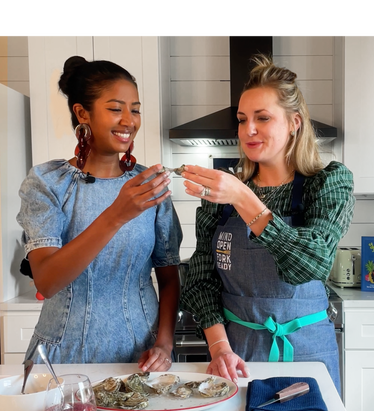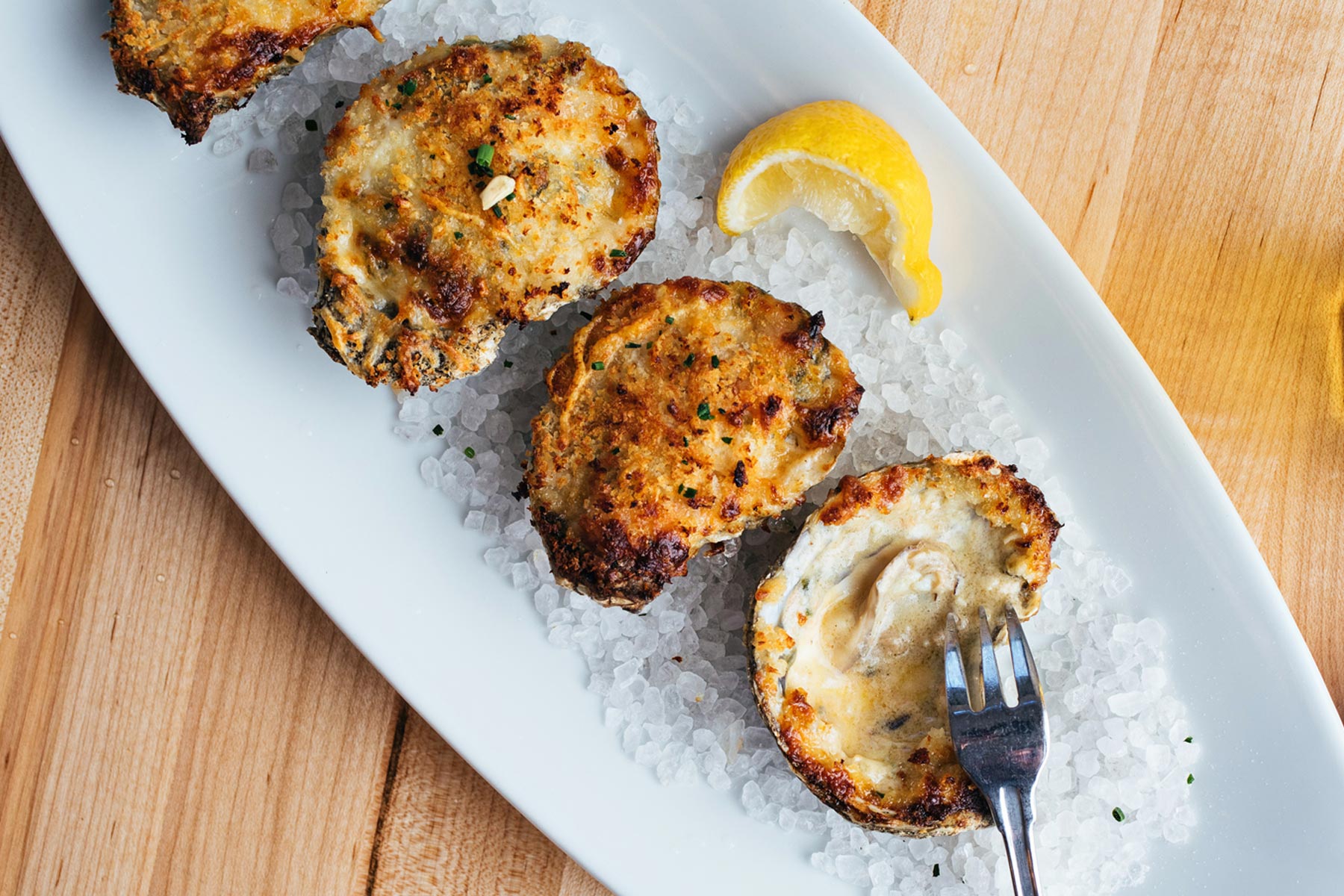
Resources
Oysters: Of Course They’re Kid Friendly!
Don’t believe us? Read on for some pearls (wink) about enjoying these briny bivalves with your kids, with preparations from all around the world.
My first encounter with a raw oyster was not one I enjoyed as a child. A platter of the glistening molluscs were carefully shucked and laid out on ice in front of me. I watched an ambitious uncle try to convince everyone that they were worth trying. An aunt whispered to me, “you won’t like them, they’re slimy”. After that resounding endorsement, I was bullied into trying one anyway. They were, in fact, “slimy” and I had no positive associations with that word, and decided I did not like oysters at all. It took me years to try them raw again. When I did, I was sitting with someone who absolutely lived for oyster happy-hour, but who also had an exceptional way of describing things. “These are amazing. You’ll love these small ones—they’re sweet, almost fruity! They’ll taste like you’re drinking a sweet melon with a hint of the sea.” Melon-flavored sea treats? Now that’s how you set someone up for a food adventure.

All of this just goes to show that the way a food is presented to you for the first time can have strong and extremely long-lasting effects on the way we think about that food. It can prevent us from engaging in what would otherwise be extremely memorable experiences, or from being open to learning about foods that are meaningful to someone else. When I chatted with our friend Chef Kelsey Barnard Clark about oysters, she noted that the texture of a raw oyster was what she would assume would be most off-putting to a kid who was unfamiliar with them—but that there were a ton of different ways to try them that she knew anyone would enjoy. “And,” she added, “once they have that familiarity with the oyster as an ingredient, you’re opening up the opportunity to try them prepared in lots of different ways, including eventually raw.”
Our friend Chef Brittanny Anderson agreed: “Not enough people feed their kids oysters, as far as I can tell. People have weird fears about oysters. There are so many ways to cook and eat them, and I’ve eaten them in every way since I was a kid. They have this reputation now, but they do not have to be luxury ingredients. I think a lot of times it comes back to fear, misunderstanding, and generalization. People will say “I hate fish”, for example, and maybe it’s because they had one poorly prepared fish one time, but to extend that to all fish is just insane to me. There are so many different kinds of oysters. There are so many ways to cook them. And then there are sauces. Fry them up, put some yummy sauce on them, and offer them to a kid with no disclaimer. There’s no way kids won’t eat them. Fried oysters are the chicken nuggets of the sea!”

Oysters have been enjoyed by coastal communities all over the world since the beginning of human history. In fact, from fossil evidence and throughout most of recorded history, oysters played a much larger role in human diets than they do today. Modern cultivation of oysters provides one of the cheapest and most sustainable sources of protein available to us today, as well as creating natural water filtration systems that improve the environment around the oyster beds. And if this wasn’t enough to dispel any lingering apprehension about them– there are countless oyster preparations enjoyed in almost every culture. I’m absolutely positive that you’ll find one that sounds delicious to you and your family. Here are just a few ideas from some of our friends, and from around the world!
Malaysia:
Oh Chien is one of the most beloved Penang street foods. There are variations of this pan fried oyster omelet found all over South East Asia, but it’s believed to be Hokkein and Teochew in origin. You can find a perfect Penang version at Kopitiam in New York City, made by our friend (and inspiration for Taste Buds in Harmony!) Chef Kyo Pang.
Thailand:
A similar street-food oyster omelet called Hoy Tod is enjoyed in Thailand, typically served with lots of aromatic condiments and toppings like fish sauce with chili peppers and green onions, among others.
Louisiana:
Think of a method of preparation, and someone has done it to an oyster in New Orleans. Grilled, baked (like Oysters Bienville), broiled, fried, roasted, raw—you’ll find them in many forms and many dishes. A favorite of mine as a kid was an Oyster Po’boy, typically double-dredged and fried briny oysters, served on a soft roll with remoulade, pickles, lettuce and tomatoes.
South Korea:
Our friend Rocky Gray grew up eating guljeon, or savory battered pan-fried oyster pancakes, as well as oyster kimchi. “Sometimes,” she said, “you’d have oysters with a traditional bo ssam as well.”
Puerto Rico:
Our friend Chef Jamilka Borges remembers always eating oysters raw, but also loved them in bright, citrusy ceviches and preserved en escabeche, with vinegar and spices.
Japan:
Japan has one of the world’s oldest traditions of cultivating oysters for consumption, with evidence of cultivated oyster beds dating back to the Muromachi period (1336-1573) and evidence of consumption dating back to prehistoric times. While individual oyster preparations are most familiar to people today, in Hiroshima, there is a specialized industry devoted to selling oysters unshelled in large quantities for dishes such as oyster hotpots, oyster rice, as well as grilled, fried, and raw. Kaki Fry are deep-fried oysters that are typically enjoyed in the fall and winter months in Japan, and are comforting and simple to make at home. They’re typically battered in flour, egg, and panko before being fried and served with lemon, tonkatsu, and tartar sauce.
Gambia:
Oysters have been harvested from the Gambian coast and mangroves for generations. There are legions of Oyster Women (so many that there is even an Oyster Women’s Association!) selling the abundance of oysters throughout the country, where people eat oysters in various dishes for breakfast, lunch and dinner. A particular speciality is oyster stew, made with oysters, fried aromatics, tomato paste, and lots of vegetables and rice. The stew is typically served on a platter and shared family-style from the same dish.
Looking for even more ways to get your family excited to try oysters? Check out our activity guide here!

